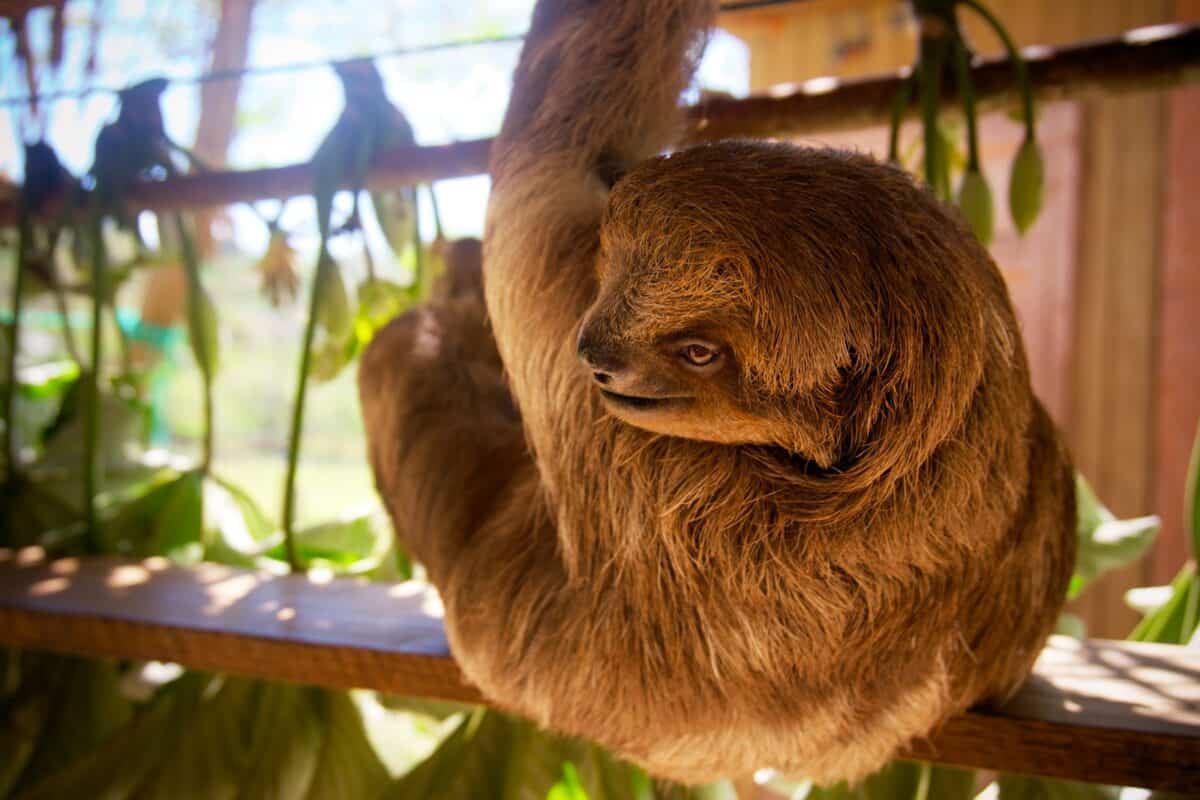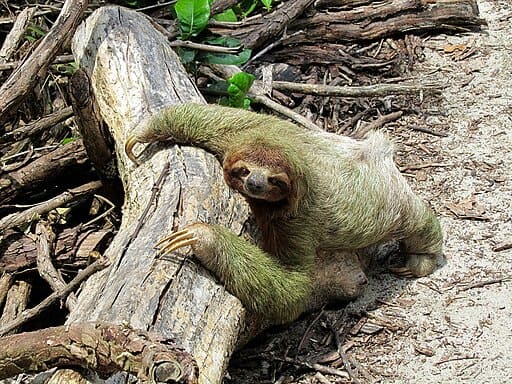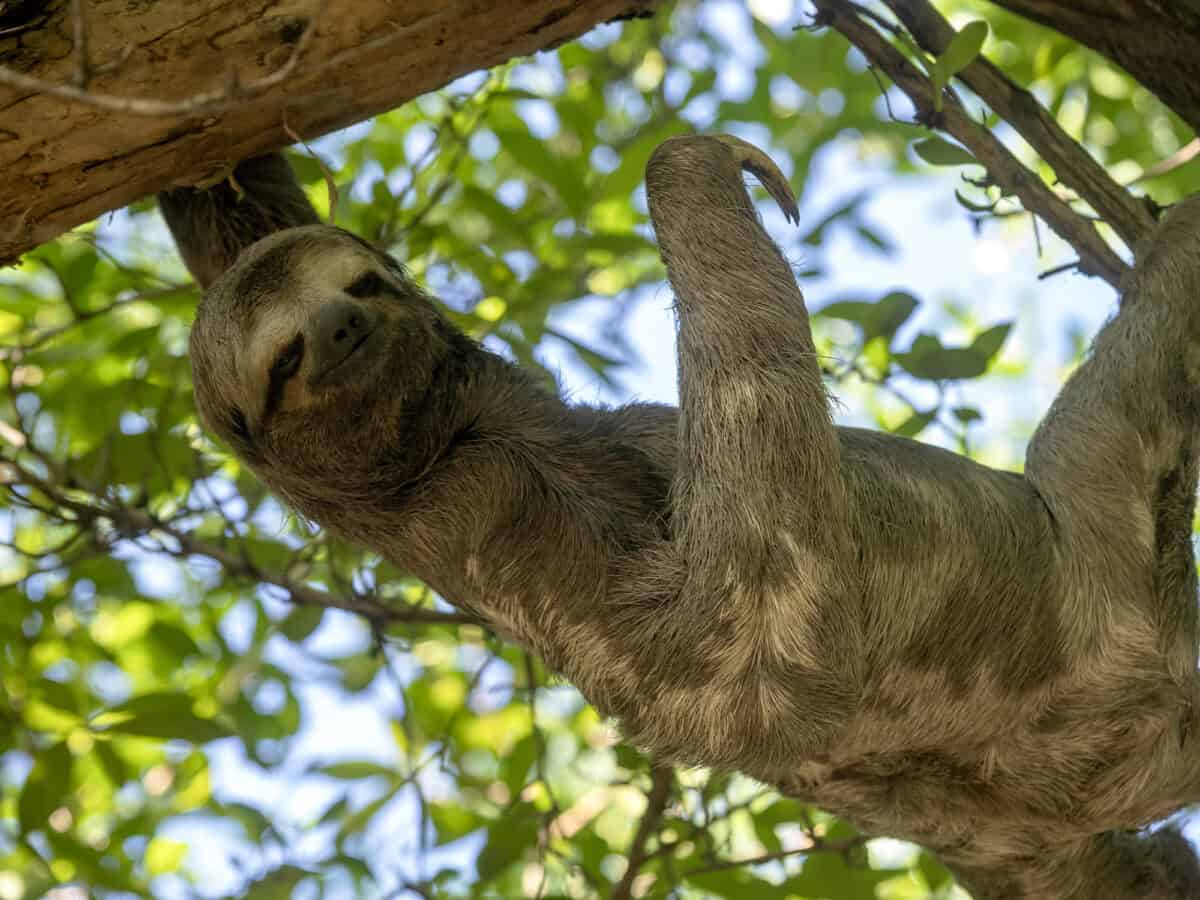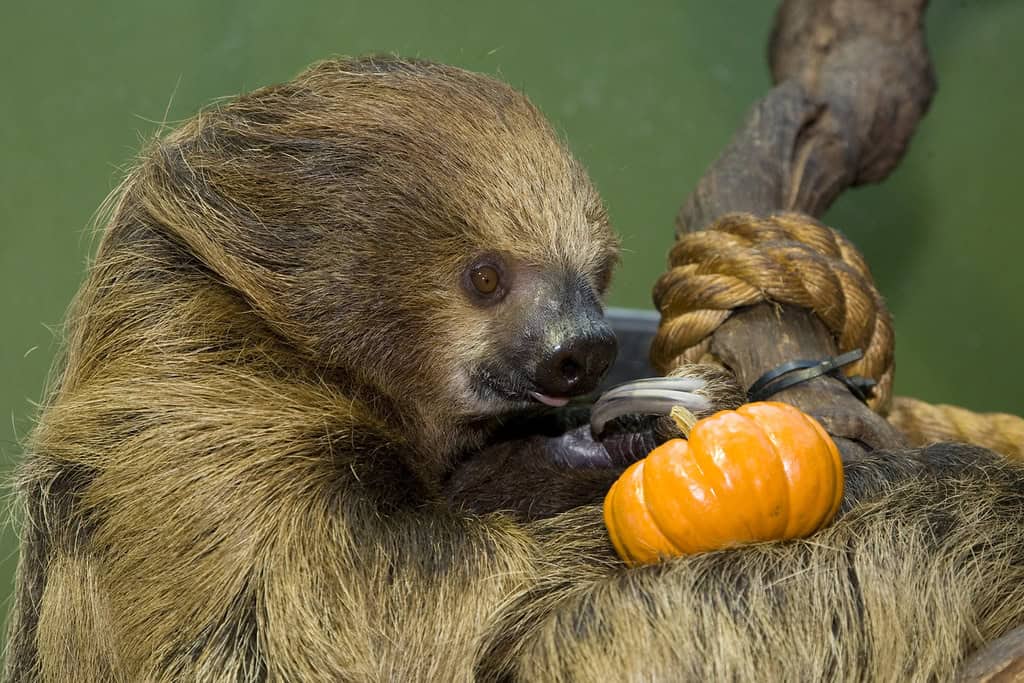Deep in the rainforests of Central and South America, one of nature’s most peculiar rituals unfolds each week. The normally sedentary sloth—an animal that spends 90% of its life hanging upside down in the canopy—descends to the forest floor for a dangerous bathroom break. This weekly journey might seem mundane, but for sloths, it’s a life-threatening expedition. Descending from their arboreal sanctuary makes these slow-moving mammals vulnerable to predators like jaguars, ocelots, and harpy eagles. Yet despite these dangers, sloths have maintained this high-risk behavior throughout their evolutionary history. Why would an animal evolve to put itself in harm’s way just to defecate? The answer reveals a fascinating web of ecological relationships and evolutionary adaptations that have puzzled scientists for decades.
The Mysterious Defecation Ritual

Three-toed sloths (genus Bradypus) engage in perhaps the most baffling bathroom behavior in the animal kingdom. Approximately once a week, these creatures laboriously descend from the safety of the treetops to the forest floor—a journey that can take up to eight hours round trip. Upon reaching the ground, they dig a small hole with their stubby tail, defecate, and then cover their waste before beginning the arduous climb back up. This entire process can consume up to 30% of a sloth’s daily energy budget—a significant investment for an animal renowned for its energy conservation.
What makes this behavior even more perplexing is that two-toed sloths (genus Choloepus), their close relatives, don’t share this risky habit. They simply defecate from the branches, letting their waste fall to the ground below—a seemingly more sensible approach that doesn’t expose them to ground predators. This stark behavioral difference between closely related species hints at some compelling evolutionary advantage that must outweigh the considerable risks for three-toed sloths.
The Predation Risk

The dangers sloths face during their bathroom excursions cannot be overstated. On the forest floor, these animals move at an agonizingly slow pace—about 6.5 feet per minute—making them easy targets for predators. Research indicates that over half of all sloth deaths occur during these ground expeditions. Jaguars, ocelots, and humans pose significant threats, and with limited defensive capabilities beyond camouflage, sloths are essentially defenseless once spotted.
Their iconic slowness, while an advantage for energy conservation in the trees, becomes a deadly liability on the ground. Sloths lack the fight-or-flight response typical of most mammals; their metabolism is too slow to support rapid movement. This evolutionary trade-off—sacrificing speed for energy efficiency—has worked remarkably well in the treetops but creates a deadly vulnerability during these necessary ground visits. The fact that sloths continue this dangerous behavior despite such high mortality rates suggests that the benefits must be substantial.
The Algal Symbiotic Relationship

The key to understanding this puzzling behavior lies in the sloth’s fur, which hosts an entire ecosystem of symbiotic organisms. A sloth’s coat contains specialized grooves that collect rainwater and promote the growth of algae, primarily of the genus Trichophilus. This algae gives many sloths their greenish tint, providing excellent camouflage in the leafy canopy. However, the relationship goes far beyond camouflage. The algae receive shelter and moisture in the sloth’s fur, while potentially providing the sloth with supplementary nutrients absorbed through the skin or consumed during grooming.
Additionally, sloth fur houses an array of moths, beetles, cockroaches, and fungi—creating a miniature biodiversity hotspot on each animal. Among these, sloth moths (family Pyralidae) play a particularly important role. These moths live exclusively in sloth fur and have synchronized their life cycle with the sloth’s bathroom habits. When a sloth descends to defecate, female moths leave the sloth’s fur to lay their eggs in the fresh dung, where their larvae will develop before emerging as adults to find another sloth host.
The Moth-Algae Connection

Researchers led by Jonathan Pauli and M. Zachariah Peery from the University of Wisconsin-Madison proposed a fascinating explanation for the sloth’s risky bathroom behavior in a 2014 study published in Proceedings of the Royal Society B. They suggested that sloths benefit from what amounts to an agricultural relationship with moths and algae. When moths lay eggs in sloth dung, the emerging adult moths later return to the sloth’s fur, bringing with them nitrogen-rich nutrients from the decomposing excrement that fertilize the algae growing in the sloth’s fur.
This creates a three-way mutualistic relationship: moths get a place to breed, algae receive nutrients for growth, and sloths potentially gain nutritional benefits by either absorbing nutrients through their skin or by licking the algae directly. The researchers found that sloths with more moths in their fur also had higher nitrogen levels in their fur algae, lending support to this hypothesis. This complex relationship could explain why three-toed sloths risk their lives to defecate on the ground—they’re essentially farming their own food supplement.
Nutritional Benefits of the Symbiosis

The algae in a sloth’s fur may represent a crucial nutritional supplement for these leaf-eating specialists. Sloths have one of the lowest-quality diets among mammals, subsisting primarily on nutrient-poor, toxin-rich leaves. Their incredibly slow metabolism—the slowest of any mammal—is an adaptation to this low-energy diet. However, even with these adaptations, sloths operate on a knife-edge of energy balance. The algae in their fur potentially provide essential nutrients that are lacking in their leaf diet.
Analysis of sloth fur algae has revealed significant levels of lipids—essentially fats that could serve as a high-energy food source. When sloths groom themselves, they may be harvesting these lipids. Additionally, the algae contain compounds not found in the leaves sloths eat, potentially providing micronutrients that help compensate for deficiencies in their primary diet. This nutritional boost could make the dangerous journey to the forest floor worthwhile from an evolutionary perspective, especially considering that sloths have remarkably small home ranges and must make the most of limited food resources.
Alternative Theories

While the moth-algae-sloth relationship offers a compelling explanation, scientists have proposed several alternative theories for this risky behavior. One hypothesis suggests that ground defecation may be related to territorial marking or mate attraction. By creating consistent bathroom spots, sloths might be leaving chemical signals for potential mates or marking territory boundaries. This communication function would be particularly valuable for these solitary animals that rarely interact directly with one another.
Another theory proposes that the behavior might help reduce parasite loads. By not defecating from the trees, sloths avoid creating parasite-friendly environments in their immediate habitat. Researchers have observed that sloth dung can harbor numerous parasites and pathogens that could potentially reinfect the animal if dropped directly below its resting sites. By concentrating their waste in specific ground locations away from their feeding areas, sloths might be practicing a form of preventative healthcare—minimizing exposure to parasites that could compromise their already limited energy reserves.
Evolutionary Origins

The evolutionary history of this behavior remains somewhat mysterious, but fossil evidence offers some clues. Giant ground sloths—the ancestors of modern tree sloths—roamed the Americas until relatively recently, with the last species disappearing around 10,000 years ago. These massive animals, some reaching the size of elephants, obviously had no need to descend trees to defecate. As their descendants adapted to an arboreal lifestyle, they may have retained certain behavioral traits from their ground-dwelling ancestors.
The divergence between two-toed and three-toed sloth defecation behaviors is particularly intriguing from an evolutionary perspective. Despite their similar appearance and ecological niche, these two groups are not closely related—they evolved their tree-dwelling lifestyle and similar adaptations independently, in a remarkable case of convergent evolution. Their different approaches to waste elimination suggest that the ground defecation behavior in three-toed sloths evolved after the two lineages diverged, likely in response to specific ecological pressures or opportunities unique to the three-toed sloth’s environment.
The Role of Sloth Dung in Forest Ecology

Sloth defecation habits play a significant role in forest nutrient cycling. By concentrating their waste in specific areas, sloths create nutrient hotspots on the forest floor that can influence plant growth patterns. Their dung is nitrogen-rich and decomposes slowly due to the sloth’s highly efficient digestive system, which can take up to a month to process a single meal. This slow-release fertilizer effect creates microhabitats that benefit certain plant species and soil organisms.
Furthermore, sloth dung serves as a crucial resource for numerous insects beyond just sloth moths. Dung beetles, flies, and various decomposers rely on these nutrient deposits. Seeds consumed by sloths also pass through their digestive system unharmed, making sloths important seed dispersers for certain rainforest plants. This ecological function highlights how a seemingly strange behavior can have far-reaching effects on ecosystem processes, creating ripple effects through the complex web of rainforest interactions.
Conservation Implications

Understanding the complex relationship between sloths, moths, and algae has important conservation implications. As deforestation fragments rainforest habitats, sloths face increasing challenges in maintaining their unique ecological relationships. Smaller forest patches mean sloths must navigate more dangerous ground territory to find suitable defecation sites, potentially disrupting the moth-algae cycle. Additionally, climate change could affect the growth of their symbiotic algae, while pesticide use in agricultural areas near forests might harm the moth populations essential to this relationship.
Conservation efforts for sloths must therefore consider not just the animals themselves but their entire symbiotic ecosystem. Protecting continuous forest corridors, establishing sloth crossings over roads, and maintaining buffer zones around sloth habitats can help preserve the conditions necessary for their unique bathroom behavior. Some conservation organizations now focus on “sloth-friendly” practices, educating local communities about the importance of preserving not just the trees sloths inhabit, but also the ground areas they need to access for their crucial bathroom breaks.
Cultural Significance

The sloth’s peculiar bathroom habits have fascinated humans for centuries. Indigenous peoples of the Amazon have long observed this behavior, incorporating it into their traditional knowledge and folklore. Several tribes consider sloths to be sacred animals precisely because of their willingness to undertake dangerous journeys for seemingly mundane purposes—a metaphor for necessary sacrifice. In some cultures, sloth movements were used to predict weather patterns, with ground descents supposedly indicating coming rains.
In modern times, sloths have become internet celebrities largely due to their unusual behaviors and appearance. Their bathroom habits, while scientifically fascinating, have contributed to their portrayal in popular culture as quirky, endearing creatures. This cultural appeal has been harnessed by conservation organizations to raise awareness about rainforest preservation. The sloth’s risky bathroom breaks serve as compelling storytelling devices that help communicate the complex interdependencies of rainforest ecosystems to the public, demonstrating how even the strangest animal behaviors can play important ecological roles.
Research Challenges and Future Directions

Studying sloth defecation behavior presents unique challenges for researchers. The behavior occurs relatively infrequently—just once weekly—and tracking sloths through dense rainforest to observe natural bathroom breaks requires immense patience. Additionally, the slow metabolism of sloths means that experimental studies take considerably longer than with most mammals. These challenges have led to innovative research methods, including GPS tracking collars with accelerometers that can detect the characteristic movements of descending to defecate.
Future research directions include investigating whether climate change is affecting the sloth-moth-algae relationship, comparing gut microbiomes between two-toed and three-toed sloths to understand digestive differences, and exploring potential pharmaceutical compounds in sloth fur ecosystems. Some scientists are also investigating whether sloth dung contains unique compounds that could explain its apparent attractiveness to certain insects. As research techniques advance, particularly in non-invasive monitoring and genetic analysis, we may soon gain deeper insights into one of nature’s most peculiar bathroom behaviors.
Conclusion: A Testament to Nature’s Complexity

The sloth’s dangerous journey to defecate on the ground represents one of nature’s most fascinating evolutionary puzzles. What initially appears to be a maladaptive behavior reveals itself as part of an intricate ecological relationship involving multiple species. This three-way symbiosis between sloths, moths, and algae demonstrates how evolution can produce solutions that seem counterintuitive but make perfect sense within their ecological context. The benefits of nutritional supplementation, parasite avoidance, and potentially communication appear to outweigh the considerable predation risks.
This bathroom behavior serves as a powerful reminder that nature’s most puzzling phenomena often conceal complex adaptations that we’re only beginning to understand. It illustrates how seemingly simple behaviors can involve sophisticated ecological relationships developed over millions of years of evolution. For sloths, the weekly trip to the forest floor represents a calculated risk—a dangerous but necessary journey that has helped these remarkable animals survive for millions of years despite their seemingly disadvantageous adaptations.
As we continue to study these fascinating creatures, the sloth’s bathroom habits remind us that conservation efforts must consider not just individual species but the intricate relationships they maintain with other organisms. The forest floor beneath the sloth’s tree is not just a bathroom—it’s a critical connection point in a complex ecological network that helps sustain the remarkable biodiversity of tropical rainforests. In the sloth’s risky bathroom break, we find a perfect example of how even the most ordinary biological functions can reveal extraordinary insights into the interconnected web of life.
- The Reason Sloths Risk Their Lives to Poop on the Ground - August 11, 2025
- Is It Okay To Domesticate Wild Animals? - August 11, 2025
- The Intelligence of Rhesus Macaques in Lab Research and Nature - August 10, 2025

